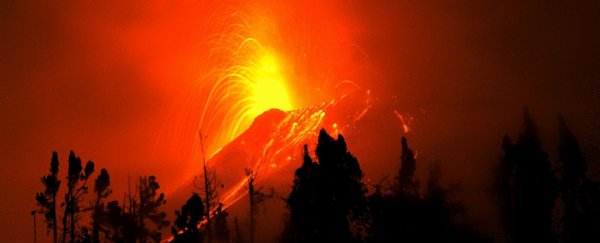Tungurahua, an active stratovolcano in Ecuador, is an ancient mountain that's picked up many names over the centuries.
In the indigenous tongue of the Quechua peoples, the name means 'Throat of Fire'. Others say Tungurahua is Quichua for 'crater'. One nickname is the Black Giant.
Something everybody can agree upon, though, is that this old volcano has been a danger for a very long time – although the latest rumblings may signify a menace greater than any ordinary eruption.
According to a new analysis, Tungurahua may be showing early warning signs of what could be a catastrophic structural collapse, thought to be due to instabilities wrought by the damage of ongoing magma activity inside the volcano.
"Using satellite data we have observed very rapid deformation of Tungurahua's west flank, which our research suggests is caused by imbalances between magma being supplied and magma being erupted," says geophysical volcanologist James Hickey from the University of Exeter in the UK.
Tungurahua has been persistently active since 1999, but if 20 years of relatively frequent eruptions seems like a long time, it's not – at least not in the lifespan of this very long-lived volcano.
Tungurahua is actually on its third life, you might say, having already endured two of these structural collapses triggered by eruptions. The first Tungurahua edifice (Tungurahua I) collapsed sometime around the end of the Late Pleistocene.
For thousands of years, the volcano then slowly rebuilt itself inside the remains of its original caldera. Then, about 3,000 years ago, Tungurahua II let forth, with another eruption prompting a partial collapse of the west flank.
When the sides of volcanoes give way like this, massive landslides can result, with avalanches of rock that can travel for up to tens of kilometres.
The collapse 3,000 years ago is thought to have unleashed a debris avalanche laying ruin to an area of some 80 square kilometres (over 11,000 football fields in size).
Given a single eruption in 1999 forced the evacuation of over 25,000 people in nearby areas, it's hard to understate the threat an actual flank collapse could pose to Tungurahua's living neighbours.
Nonetheless, according to Hickey and his team's modelling, significant surface deformation on Tungurahua's west flank (involving temporary uplift of about 3.5 cm, resulting from recent volcanic activity), is suggestive that a collapse could perhaps occur if the stresses do not abate.
"Shallow and rapid pressurisation from this inclined deformation source can generate shear stress along the collapse surface, which increases with greater volumes of magma," the authors write in their paper.
"This may contribute to slope instability during future unrest episodes and promote flank failure, with general application to other volcanoes worldwide displaying asymmetric deformation patterns."
That said, the researchers acknowledge that their study is no prediction of certain doom. If anything, the findings could help us monitor these processes, so we can try to anticipate ahead of time what future conditions might trigger catastrophe.
"Magma supply is one of a number of factors that can cause or contribute to volcanic flank instability, so while there is a risk of possible flank collapse, the uncertainty of these natural systems also means it could remain stable," Hickey says.
Let's hope so. If not, the throat of fire may be about to speak again, and it won't be good news for anyone close enough to hear.
The findings are reported in Earth and Planetary Science Letters.
